10-[记录操作]--数据的查:单表查询,约束
1、 单表查询的语法
select distinct 字段1,字段2,字段3 from 库.表 where 条件 group by 分组条件 having 过滤 order by 排序字段 limit n; # 限制条数
2、关键字的执行优先级(重点)
# 重点中的重点:关键字的执行优先级 from # 1.找到表:from where # 2.拿着where指定的约束条件,去文件/表中取出一条条记录 group by # 3.将取出的一条条记录进行分组group by,如果没有group by,则整体作为一组 having # 4.将分组的结果进行having过滤 select # 5.执行select distinct # 6.去重 order by # 7.将结果按条件排序:order by limit # 8.限制结果的显示条数
详细见:http://www.cnblogs.com/linhaifeng/articles/7372774.html
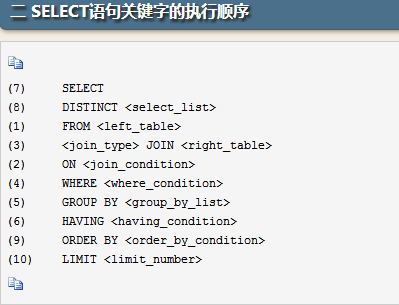
3、创建表,插入数据


#创建表 create table employee( id int not null unique auto_increment, name varchar(20) not null, sex enum('male','female') not null default 'male', #大部分是男的 age int(3) unsigned not null default 28, hire_date date not null, post varchar(50), post_comment varchar(100), salary double(15,2), office int, #一个部门一个屋子 depart_id int );
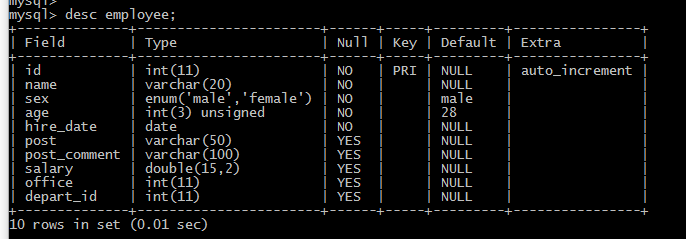

#插入记录 #三个部门:教学,销售,运营 insert into employee(name,sex,age,hire_date,post,salary,office,depart_id) values ('egon','male',18,'20170301','老男孩驻沙河办事处外交大使',7300.33,401,1), #以下是教学部 ('alex','male',78,'20150302','teacher',1000000.31,401,1), ('wupeiqi','male',81,'20130305','teacher',8300,401,1), ('yuanhao','male',73,'20140701','teacher',3500,401,1), ('liwenzhou','male',28,'20121101','teacher',2100,401,1), ('jingliyang','female',18,'20110211','teacher',9000,401,1), ('jinxin','male',18,'19000301','teacher',30000,401,1), ('成龙','male',48,'20101111','teacher',10000,401,1), ('歪歪','female',48,'20150311','sale',3000.13,402,2),#以下是销售部门 ('丫丫','female',38,'20101101','sale',2000.35,402,2), ('丁丁','female',18,'20110312','sale',1000.37,402,2), ('星星','female',18,'20160513','sale',3000.29,402,2), ('格格','female',28,'20170127','sale',4000.33,402,2), ('张野','male',28,'20160311','operation',10000.13,403,3), #以下是运营部门 ('程咬金','male',18,'19970312','operation',20000,403,3), ('程咬银','female',18,'20130311','operation',19000,403,3), ('程咬铜','male',18,'20150411','operation',18000,403,3), ('程咬铁','female',18,'20140512','operation',17000,403,3) ; #ps:如果在windows系统中,插入中文字符,select的结果为空白,可以将所有字符编码统一设置成gbk
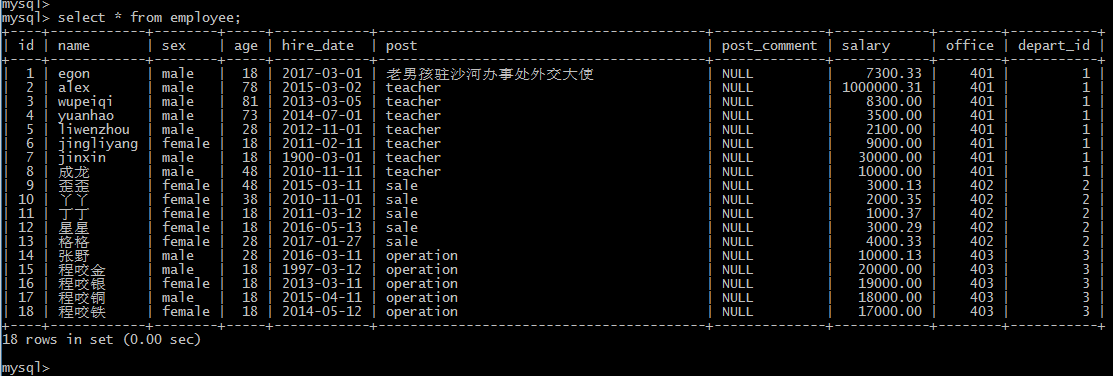
4、查询
#简单查询 SELECT id,name,sex,age,hire_date,post,post_comment,salary,office,depart_id FROM employee; SELECT * FROM employee; #效率低下 SELECT name,salary FROM employee; #避免重复DISTINCT SELECT DISTINCT post FROM employee;
#通过四则运算查询 别名 SELECT name, salary*12 FROM employee; SELECT name, salary*12 AS Annual_salary FROM employee; SELECT name, salary*12 Annual_salary FROM employee;
#定义显示格式 CONCAT() # 函数用于连接字符串 SELECT CONCAT('姓名: ',name,' 年薪: ', salary*12) AS Annual_salary FROM employee; CONCAT_WS() # 第一个参数为分隔符 SELECT CONCAT_WS(':',name,salary*12) AS Annual_salary FROM employee;
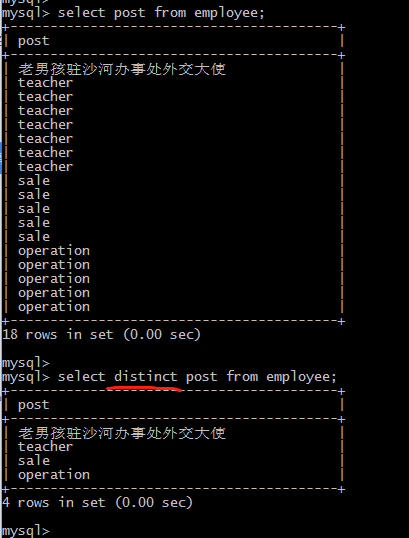
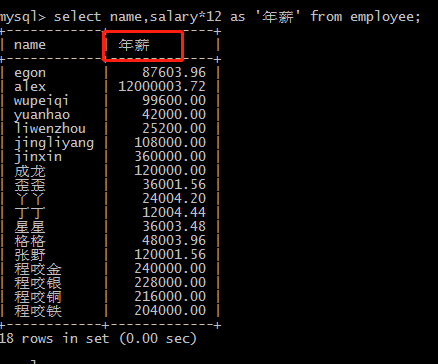
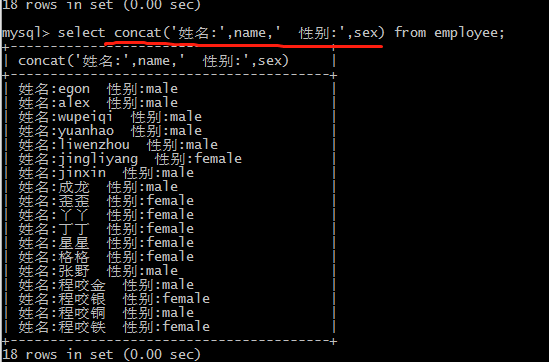
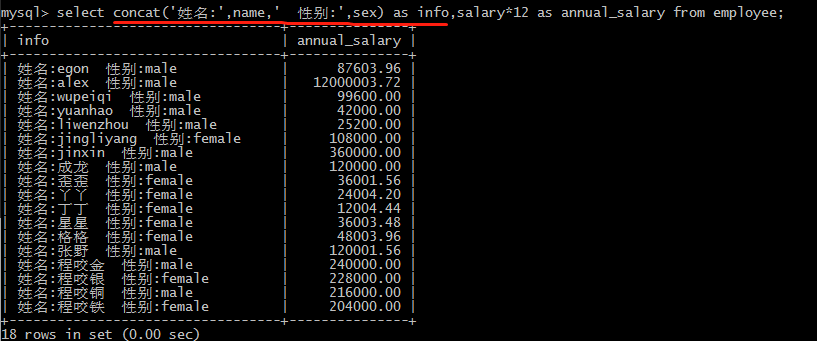
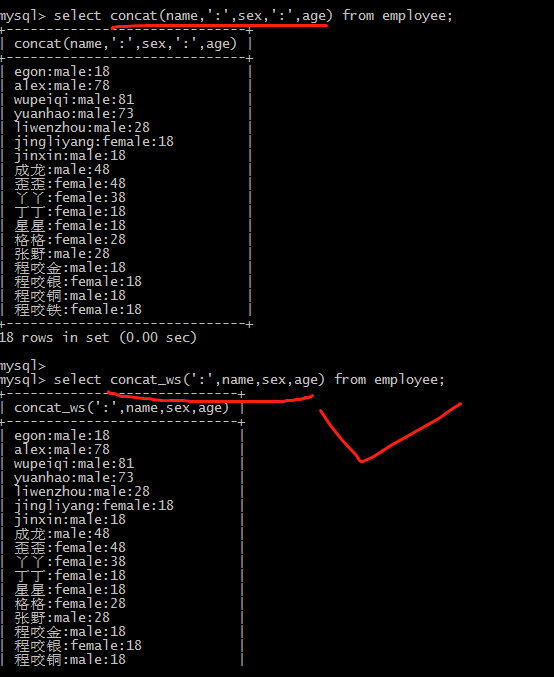

查出所有员工的名字,薪资,格式为 < 名字:egon > < 薪资:3000 > 2 查出所有的岗位(去掉重复) 3 查出所有员工名字,以及他们的年薪,年薪的字段名为annual_year select concat('<名字:',name,'> ','<薪资:',salary,'>') from employee; select distinct depart_id from employee; select name,salary*12 annual_salary from employee;
5、WHERE约束
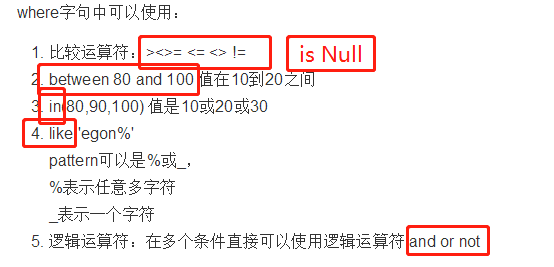
#1:单条件查询 select id,name,age from employee where id > 7; #2:多条件查询 select name,post,salary from employee where post='teacher' and salary > 8000; #3:关键字BETWEEN AND select name,salary from employee where salary >= 20000 and salary <= 30000; select name,salary from employee where salary between 20000 and 30000; select name,salary from employee where salary < 20000 or salary > 30000; select name,salary from employee where salary not between 20000 and 30000; #5:关键字IN集合查询 select * from employee where age = 73 or age = 81 or age = 28; select * from employee where age in (73,81,28); #4:关键字IS NULL(判断某个字段是否为NULL不能用等号,需要用IS) select * from employee where post_comment is Null; select * from employee where post_comment is not Null; #6:关键字LIKE模糊查询 select * from employee where name like "jin%"; # 通配符’%’ select * from employee where name like "jin___"; # 通配符’_’
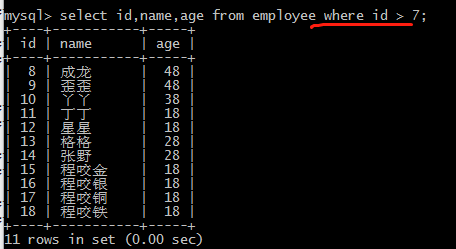



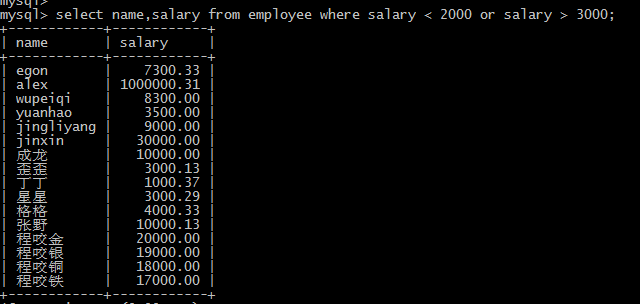
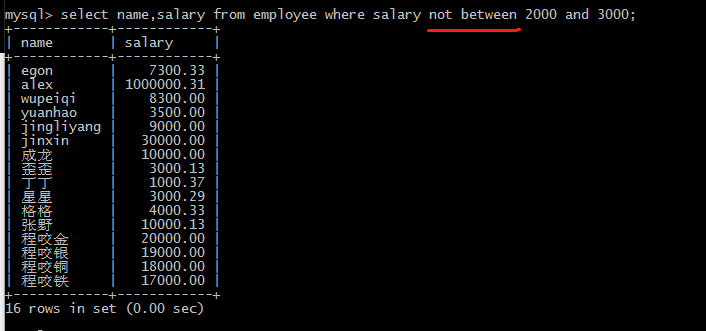

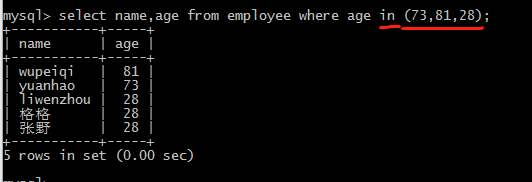




1. 查看岗位是teacher的员工姓名、年龄 2. 查看岗位是teacher且年龄大于30岁的员工姓名、年龄 3. 查看岗位是teacher且薪资在9000-1000范围内的员工姓名、年龄、薪资 4. 查看岗位描述不为NULL的员工信息 5. 查看岗位是teacher且薪资是10000或9000或30000的员工姓名、年龄、薪资 6. 查看岗位是teacher且薪资不是10000或9000或30000的员工姓名、年龄、薪资 7. 查看岗位是teacher且名字是jin开头的员工姓名、年薪

select name,age from employee where post = 'teacher'; select name,age from employee where post='teacher' and age > 30; select name,age,salary from employee where post='teacher' and salary between 9000 and 10000; select * from employee where post_comment is not null; select name,age,salary from employee where post='teacher' and salary in (10000,9000,30000); select name,age,salary from employee where post='teacher' and salary not in (10000,9000,30000); select name,salary*12 from employee where post='teacher' and name like 'jin%';
6、分组group by
(1)为什么要分组
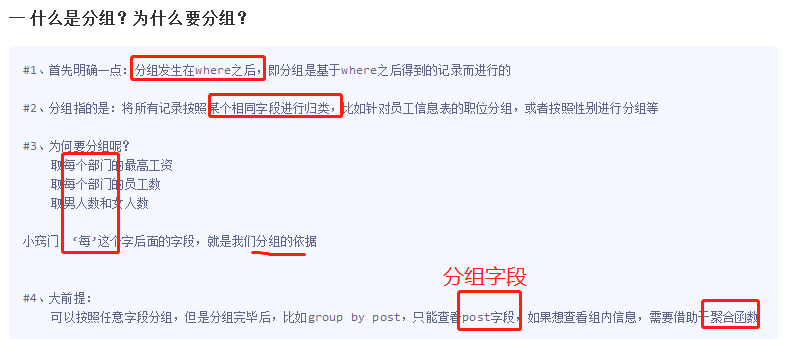
(2)设置严格分组格式
#查看MySQL 5.7默认的sql_mode如下: mysql> select @@global.sql_mode; ONLY_FULL_GROUP_BY,STRICT_TRANS_TABLES,NO_ZERO_IN_DATE,NO_ZERO_DATE,ERROR_FOR_DIVISION_BY_ZERO,NO_AUTO_CREATE_USER,NO_ENGINE_SUBSTITUTION #!!!注意 ONLY_FULL_GROUP_BY的语义就是确定select target list中的所有列的值都是明确语义,简单的说来,在ONLY_FULL_GROUP_BY模式下,target list中的值要么是来自于聚集函数的结果,要么是来自于group by list中的表达式的值。 #设置sql_mole如下操作(我们可以去掉ONLY_FULL_GROUP_BY模式): mysql> set global sql_mode='STRICT_TRANS_TABLES,NO_ZERO_IN_DATE,NO_ZERO_DATE,ERROR_FOR_DIVISION_BY_ZERO,NO_AUTO_CREATE_USER,NO_ENGINE_SUBSTITUTION'; !!!SQL_MODE设置!!!
#由于没有设置ONLY_FULL_GROUP_BY,于是也可以有结果,默认都是组内的第一条记录,但其实这是没有意义的

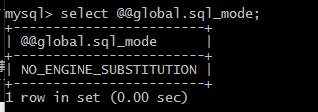
mysql> set global sql_mode='ONLY_FULL_GROUP_BY'; Query OK, 0 rows affected (0.00 sec)

#设置成功后,一定要退出,然后重新登录方可生效 mysql> select * from emp group by post; #报错 ERROR 1055 (42000): 'db1.emp.id' isn't in GROUP BY mysql> select post,count(id) from emp group by post; #只能查看分组依据和使用聚合函数


(3)GROUP_CONCAT()函数
GROUP BY关键字和GROUP_CONCAT()函数一起使用 SELECT post,GROUP_CONCAT(name) FROM employee GROUP BY post;#按照岗位分组,并查看组内成员名 SELECT post,GROUP_CONCAT(name) as emp_members FROM employee GROUP BY post;

7、聚合函数 max、min、avg、sum、count

# 强调:聚合函数聚合的是组的内容,若是没有分组,则默认一组 # 分组之后,只能取分组的字段,以及每个组聚合结果

#没有group by则默认整体算作一组 select max(salary) from employee;
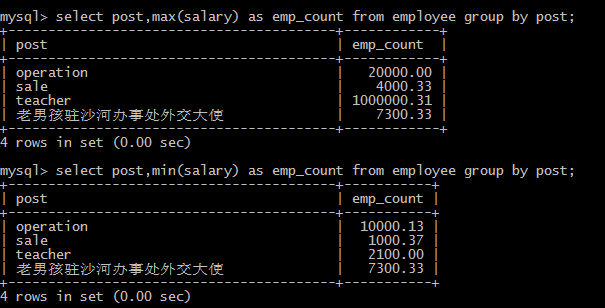

1. 查询岗位名以及岗位包含的所有员工名字 2. 查询岗位名以及各岗位内包含的员工个数 3. 查询公司内男员工和女员工的个数 4. 查询岗位名以及各岗位的平均薪资 5. 查询岗位名以及各岗位的最高薪资 6. 查询岗位名以及各岗位的最低薪资 7. 查询男员工与男员工的平均薪资,女员工与女员工的平均薪资

#题1:分组 mysql> select post,group_concat(name) from employee group by post; +-----------------------------------------+---------------------------------------------------------+ | post | group_concat(name) | +-----------------------------------------+---------------------------------------------------------+ | operation | 张野,程咬金,程咬银,程咬铜,程咬铁 | | sale | 歪歪,丫丫,丁丁,星星,格格 | | teacher | alex,wupeiqi,yuanhao,liwenzhou,jingliyang,jinxin,成龙 | | 老男孩驻沙河办事处外交大使 | egon | +-----------------------------------------+---------------------------------------------------------+ #题目2: mysql> select post,count(id) from employee group by post; +-----------------------------------------+-----------+ | post | count(id) | +-----------------------------------------+-----------+ | operation | 5 | | sale | 5 | | teacher | 7 | | 老男孩驻沙河办事处外交大使 | 1 | +-----------------------------------------+-----------+ #题目3: mysql> select sex,count(id) from employee group by sex; +--------+-----------+ | sex | count(id) | +--------+-----------+ | male | 10 | | female | 8 | +--------+-----------+ #题目4: mysql> select post,avg(salary) from employee group by post; +-----------------------------------------+---------------+ | post | avg(salary) | +-----------------------------------------+---------------+ | operation | 16800.026000 | | sale | 2600.294000 | | teacher | 151842.901429 | | 老男孩驻沙河办事处外交大使 | 7300.330000 | +-----------------------------------------+---------------+ #题目5 mysql> select post,max(salary) from employee group by post; +-----------------------------------------+-------------+ | post | max(salary) | +-----------------------------------------+-------------+ | operation | 20000.00 | | sale | 4000.33 | | teacher | 1000000.31 | | 老男孩驻沙河办事处外交大使 | 7300.33 | +-----------------------------------------+-------------+ #题目6 mysql> select post,min(salary) from employee group by post; +-----------------------------------------+-------------+ | post | min(salary) | +-----------------------------------------+-------------+ | operation | 10000.13 | | sale | 1000.37 | | teacher | 2100.00 | | 老男孩驻沙河办事处外交大使 | 7300.33 | +-----------------------------------------+-------------+ #题目七 mysql> select sex,avg(salary) from employee group by sex; +--------+---------------+ | sex | avg(salary) | +--------+---------------+ | male | 110920.077000 | | female | 7250.183750 | +--------+---------------+
8、HAVING过滤
HAVING与WHERE不一样的地方在于!!!!!!
#!!!执行优先级从高到低:where > group by > having #1. Where 发生在分组group by之前,因而Where中可以有任意字段,但是绝对不能使用聚合函数。 #2. Having发生在分组group by之后,因而Having中可以使用分组的字段,无法直接取到其他字段,可以使用聚合函数
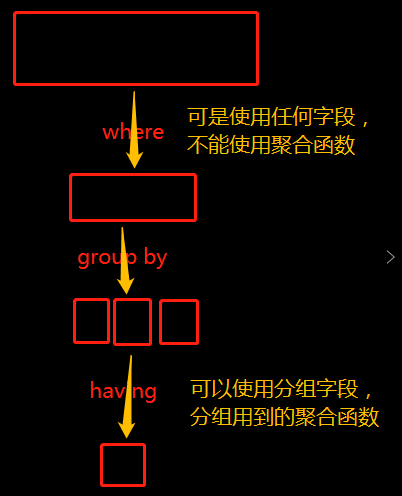

#having select post,group_concat(name),count(id) from employee group by post; select post,group_concat(name),count(id) from employee group by post having count(id) < 2; select post,avg(salary) from employee group by post having avg(salary) > 10000;



# 小练习: 1. 查询各岗位内包含的员工个数小于2的岗位名、岗位内包含员工名字、个数 3. 查询各岗位平均薪资大于10000的岗位名、平均工资 4. 查询各岗位平均薪资大于10000且小于20000的岗位名、平均工资

#题1: mysql> select post,group_concat(name),count(id) from employee group by post having count(id) < 2; +-----------------------------------------+--------------------+-----------+ | post | group_concat(name) | count(id) | +-----------------------------------------+--------------------+-----------+ | 老男孩驻沙河办事处外交大使 | egon | 1 | +-----------------------------------------+--------------------+-----------+ #题目2: mysql> select post,avg(salary) from employee group by post having avg(salary) > 10000; +-----------+---------------+ | post | avg(salary) | +-----------+---------------+ | operation | 16800.026000 | | teacher | 151842.901429 | +-----------+---------------+ #题目3: mysql> select post,avg(salary) from employee group by post having avg(salary) > 10000 and avg(salary) <20000; +-----------+--------------+ | post | avg(salary) | +-----------+--------------+ | operation | 16800.026000 | +-----------+--------------+
-
-
执行顺序 having ----->select ---->order
-
# having 执行完才执行 select 然后执行 order select distinct post,count(id) as emp_count from employee where salary > 1000 group by post having emp_count > 1 # select中有这个别名 order by emp_count ; select distinct post,count(id) as emp_count from employee where salary > 1000 group by post having count(id) > 1 order by emp_count ;

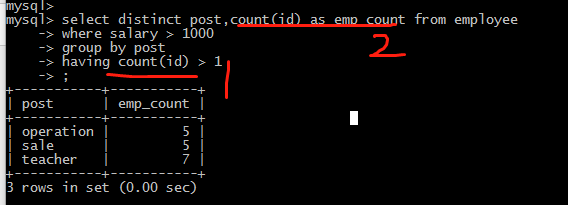
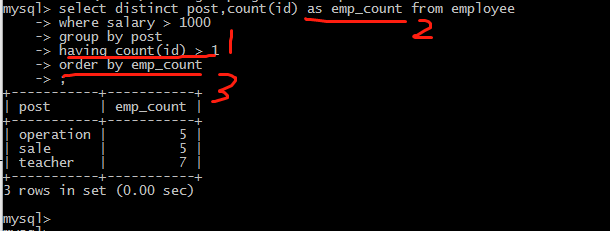

9、查询排序:ORDER BY
按单列排序 select * from employee order by age asc; #升序 select * from employee order by age desc; #降序 按多列排序:先按照age排序,如果年纪相同,则按照薪资排序 select * from employee order by age asc,id desc; #先按照age升序排,如果age相同则按照id降序排
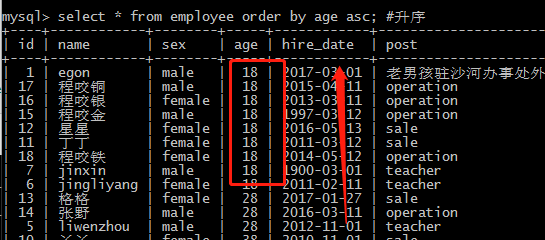


1. 查询所有员工信息,先按照age升序排序,如果age相同则按照hire_date降序排序 2. 查询各岗位平均薪资大于10000的岗位名、平均工资,结果按平均薪资升序排列 3. 查询各岗位平均薪资大于10000的岗位名、平均工资,结果按平均薪资降序排列

#题目1 mysql> select * from employee ORDER BY age asc,hire_date desc; #题目2 mysql> select post,avg(salary) from employee group by post having avg(salary) > 10000 order by avg(salary) asc; +-----------+---------------+ | post | avg(salary) | +-----------+---------------+ | operation | 16800.026000 | | teacher | 151842.901429 | +-----------+---------------+ #题目3 mysql> select post,avg(salary) from employee group by post having avg(salary) > 10000 order by avg(salary) desc; +-----------+---------------+ | post | avg(salary) | +-----------+---------------+ | teacher | 151842.901429 | | operation | 16800.026000 | +-----------+---------------+
10、限制查询的记录数:LIMIT
示例: select * from employee limit 3; #默认初始位置为0 select * from employee order by salary desc limit 1;


# 分页 select * from employee limit 0,5; # 从第0开始,即先查询出第一条,然后包含这一条在内往后查5条 select * from employee limit 5,5; # 从第5开始,即先查询出第6条,然后包含这一条在内往后查5条 select * from employee limit 10,5; select * from employee limit 15,5;




11、正则表达式
select * from employee where name like 'jin%'; select * from employee where name regexp '^jin'; select * from employee where name regexp '^jin.*(g|n)$';



12、单表查询语法顺序与执行顺序



# 执行顺序: def from(db,table): f=open(r'%s\%s' %(db,table)) return f def where(condition,f): for line in f: if condition: yield line def group(lines): pass def having(group_res): pass def distinct(having_res): pass def order(distinct_res): pass def limit(order_res) pass def select(): f=from('db1','t1') lines=where('id>3',f) group_res=group(lines) having_res=having(group_res) distinct_res=distinct(having_res) order_res=order(distinct_res) res=limit(order_res) print(res) return res


